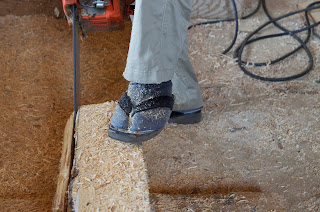The offcuts from the stern of the side planking are laid over the aft planking to form a second layer of reinforced planking in this area.
A shot of Murakami piloting a hole for a nail fastening the rubrail.
A shot of a clench nail from the side of the rub rail through the planking.
The rub rail dives in flush to the planking at the bow, a feature I have never seen on a Japanese boat before.
Aft the plank reinforcement is clamped in place with dogs then clench-nailed.
The director and curator of the local museum stop by and share an article with us about another local boatbuilder, long since passed away.
Note the boatbuilding working outside, holding the backbone of the boat in place with stones. Sadly, the author of this book was killed in the tsunami.
Murakami san told us sometimes boatbuilders worked at their customers homes and therefore had to improvise and work outside. He said some customers demanded to be able to watch the process!
Roughing out the stem, though this photo illustrates chainsawing in sandals. Disclaimer: do not try this at home or at work.
The hatch over the live well, aft floorboards visible behind.
Murakami san roughing out the stem with an axe...
... and an adze. He calls the axe the masakari, which is a term used in northern Japan (ono everywhere else). The adze is the chouna.
Murakami san told us he planted this hinoki himself thirty-five years ago. By the way, this is a false stem, applied to an inner stem which our planks are nailed too. Again, this is a first for me in Japan.
Down at the cove there are two four-plank boats that feature rabbeted stems and here is a look at the joinery that is visible in the stem/keel connection.
Murakami san built this boat but said a rabbeted stem was a pain to build.
Enclosure aft under the shelf at the transom.
Angela may have taken the photo of the project. The light is perfect and she caught wood chips in midair. Murakami san stood on the bow and adzed a recurve in the head of the stem. His work with the axe and adze is impressive.
Read Angela's impressions of the project at her blog: http://angelarobins.com/blog




















No comments:
Post a Comment
Note: Only a member of this blog may post a comment.